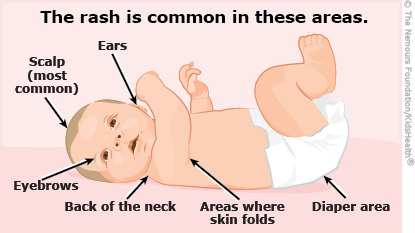- Parents Home
- Para Padres
- A to Z Dictionary
- Allergy Center
- Asthma
- Cancer
- Diabetes
- Diseases & Conditions
- Doctors & Hospitals
- Emotions & Behavior
- First Aid & Safety
- Flu (Influenza)
- Food Allergies
- General Health
- Growth & Development
- Heart Health & Conditions
- Homework Help Center
- Infections
- Newborn Care
- Nutrition & Fitness
- Play & Learn
- Pregnancy Center
- Preventing Premature Birth
- Q&A
- School & Family Life
- Sports Medicine
- Teens Home
- Para Adolescentes
- Asthma
- Be Your Best Self
- Body & Skin Care
- Cancer
- Diabetes
- Diseases & Conditions
- Drugs & Alcohol
- Flu (Influenza)
- Homework Help
- Infections
- Managing Your Weight
- Medical Care 101
- Mental Health
- Nutrition & Fitness
- Q&A
- Safety & First Aid
- School, Jobs, & Friends
- Sexual Health
- Sports Medicine
- Stress & Coping
Cradle Cap (Seborrheic Dermatitis) in Infants
What Is Cradle Cap?
Cradle cap is the common term for seborrheic dermatitis (seb-eh-REE-ik dur-muh-TYE-tis) of the scalp in infants.
Seborrheic dermatitis, also called seborrhea (seb-eh-REE-uh), can show up:
- on the scalp
- on the forehead and face
- behind the ears
- in the diaper area, armpits, and other skin folds and creases
What Are the Signs & Symptoms of Cradle Cap (Seborrheic Dermatitis)?
Babies can develop seborrheic dermatitis when they're between 2 weeks and 12 months old. It usually starts with cradle cap. A baby with cradle cap will have slightly red scaly or crusty yellow patches on the scalp. It may also start on the face or diaper area and spread to other parts of the body.
Seborrhea looks:
- red and moist in skin creases and folds (like the neck and behind the ears)
- yellowish with greasy patches or crusts
- scaly or flaky

Seborrheic dermatitis might look uncomfortable or irritating to the skin. But it usually isn't itchy and doesn't seem to bother infants.
What Causes Cradle Cap (Seborrheic Dermatitis)?
The exact cause of cradle cap isn't known. It's likely due to a combination of things. Too much skin oil (sebum) in the oil glands and hair follicles and a type of yeast found on the skin called Malassezia may play roles in the development of seborrheic dermatitis.
How Is Cradle Cap (Seborrheic Dermatitis) Diagnosed?
Health care professionals can diagnose cradle cap and seborrheic dermatitis by the way the skin looks and where the rash is. Babies with seborrheic dermatitis are usually well and the condition should get better on its own or with treatment.
How Is Cradle Cap (Seborrheic Dermatitis) Treated?
Cradle cap and seborrheic dermatitis in infants usually clears up on its own in weeks or months. In the meantime, you may want to loosen and remove the scales on your baby's scalp:
- Wash your baby's hair once a day with mild, tear-free baby shampoo.
- Gently remove scales with a soft brush or toothbrush.
- If the scales don't loosen easily, apply a small amount of mineral oil or petroleum jelly to your baby's scalp. Let the oil to soak into the scales for a few minutes to several hours, if needed. Then use a soft brush or toothbrush to remove scales. Shampoo your baby's hair as usual.
If regular shampooing doesn't help, your doctor may recommend a mild steroid cream or antifungal shampoo.
For seborrhea on other parts of the body, your doctor may recommend a mild steroid or antifungal cream.
Do not use over-the-counter steroid or antifungal creams or anti-seborrhea shampoos without checking first with the doctor.
What Else Should I Know?
Sometimes seborrheic dermatitis in the diaper area or skin folds can get infected. Talk to your doctor if the rash gets worse or there are any signs of infection (the skin looks red, starts to drain fluid, or feels warm).
Cradle cap and seborrheic dermatitis in infants usually get better by 12 months of age. Seborrhea may come back around puberty as dandruff.

© 1995- The Nemours Foundation. KidsHealth® is a registered trademark of The Nemours Foundation. All rights reserved.
Images sourced by The Nemours Foundation and Getty Images.
